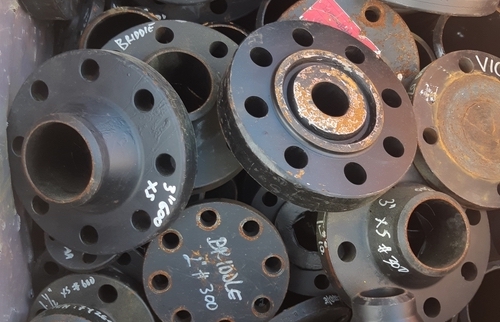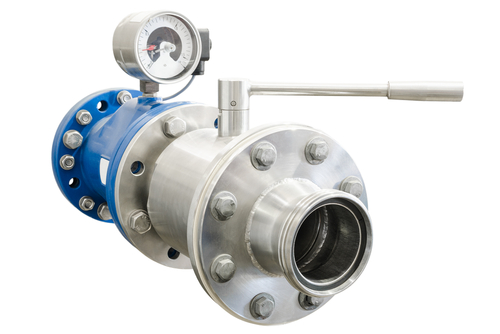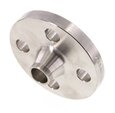How Flange Ratings Work

Figure 1: Flanges
A flange rating is a measurement that indicates the maximum allowable pressure and temperature that a flange can withstand. A flange rating is also referred to as a flange class or pressure class. Flange ratings are typically designated by a numerical value, such as Class 150, Class 300, and Class 600; the higher numbers indicate greater pressure and temperature resistance. This article discusses flange ratings and how to select a flange for an application.
View our online selection of flange valves and seals!
Flange class
ASME designed the flange class, considering the various pressure and temperature ratings. There are seven Classes - 150, 300, 400, 600, 900, 1500, and 2500. The rating indicates the maximum allowable pressure at a given temperature. For example, a Class 300 flange can withstand more pressure and is heavier than a Class 150 flange. A Class 300 flange means that the flange's safe working pressure at the rated temperature for a given material is 300 psi (20.6 bar).

Figure 2: Flange ratings
Flange rating standards
Flange ratings are standardized by organizations like the American National Standards Institute (ANSI) and the American Society of Mechanical Engineers (ASME) to ensure that flanges and their associated piping systems are compatible and can safely handle the required operating conditions. The most common flange rating standards are:
- ANSI/ASME B16.5: This standard covers flanges and flanged fittings from NPS ½ (DN 15) to NPS 24 (DN 600) and specifies pressure classes ranging from 150 to 2500. The pressure classes indicate the flange's maximum allowable working pressure at various temperatures.
- ANSI/ASME B16.47: This standard covers larger flanges from NPS 26 (DN 650) to NPS 60 (DN 1500) and specifies pressure classes ranging from 75 to 900.
Example
Table 1 shows the flange rating in psig for common carbon steel ASME flanges. The table shows that the allowable pressure in a Class 150 flange is 285 psi (19.6 bar) at 100 °F (37.7 °C) and 65 psi (4.5 bar) at 850 °F (454.5 °C). The flange is rated for 150 psi (10.3 bar) only at around 500 °F (260 °C). Higher-class flanges are rated at their nominal pressure only at around 850 °F (454.4 °C) (see Table 1).
Consider an application with a pressure rating of 800 psi (55.1 bar) at 500𐩑F (260 °C). Refer to Table 1 to select a suitable flange for this application. From Table 1, it's clear that a flange with a Class 400 rating meets the requirement as it can withstand 800 psi (55.1 bar) pressure at 500 °F. Always choose the flange rating that matches or exceeds the expected operating conditions to ensure a safe and reliable operation.
Table 1: Flanges pressure rating in psig for common carbon steel ASME flanges
Pressure (psi) |
|||||||
| Temperature (𐩑F) | 150# | 300# | 400# | 600# | 900# | 1500# | 2500# |
| -20 to 100 | 285 | 740 | 985 | 1480 | 2220 | 3705 | 6170 |
| 200 | 260 | 680 | 905 | 1360 | 2035 | 3395 | 5655 |
| 300 | 230 | 655 | 870 | 1310 | 1965 | 3270 | 5450 |
| 400 | 200 | 635 | 845 | 1265 | 1900 | 3170 | 5280 |
| 500 | 170 | 605 | 805 | 1205 | 1810 | 3015 | 5025 |
| 600 | 140 | 570 | 755 | 1135 | 1705 | 2840 | 4730 |
| 650 | 125 | 550 | 730 | 1100 | 1650 | 2745 | 4575 |
| 700 | 110 | 530 | 710 | 1060 | 1590 | 2655 | 4425 |
| 750 | 95 | 505 | 675 | 1015 | 1520 | 2535 | 4230 |
| 800 | 80 | 410 | 550 | 825 | 1235 | 2055 | 3430 |
| 850 | 65 | 320 | 425 | 640 | 955 | 1595 | 2655 |
| 900 | 50 | 230 | 305 | 460 | 690 | 1150 | 1915 |
| 950 | 35 | 135 | 185 | 275 | 410 | 685 | 1145 |
| 1000 | 20 | 85 | 115 | 170 | 255 | 430 | 715 |
Other notes
- Combination of flange ratings: When two flanges with different pressure ratings are joined together, the assembly's maximum pressure rating will be limited by the lowest-rated component. Adequate matching of flanges is crucial for maintaining the integrity of the system.
- Non-standard flange ratings: Some applications may require custom or non-standard flange ratings beyond what ASME or ANSI standards define. These custom flanges must be designed and tested according to specific project requirements and may need approval from relevant regulatory authorities.
Flanges in industries

Figure 3: Valve with flange connection
Flanges allow for the easy assembly and disassembly of valves within a piping system. They can be bolted together to create a strong and secure connection, which helps in the maintenance and inspection of the system. Flanges create a tight seal, preventing leaks and ensuring proper containment of fluid or other materials being transported through the piping system. They can be used with gaskets or other sealing materials to enhance their sealing capabilities.
FAQs
How are flange ratings affected by temperature?
Flange ratings are temperature-dependent. As the temperature increases, the pressure-handling capacity of the flange decreases.
What are the most common flange ratings used in industrial applications?
In industrial applications, flange ratings such as Class 150, Class 300, and Class 600 are commonly used.












